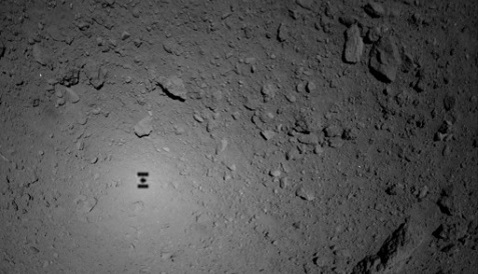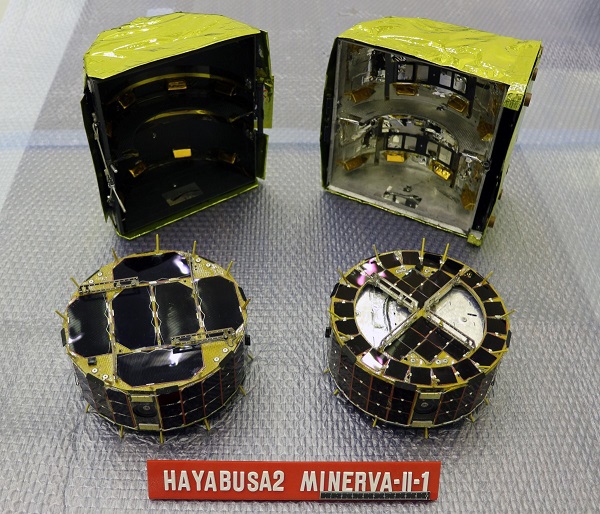The Japanese Hayabusa 2 spacecraft dispatched the first of a set of smaller missions that will explore asteroid 162173 Ryugu.

JAXA
They made it!
The Japanese Aerospace Exploration Agency's intrepid Hayabusa 2 mission deployed the first of a series of asteroid landers and rovers early Friday morning on September 21st, at 4:06 UT / 12:06 a.m. EDT.
Built by a team at the University of Aizu, Japan, the MIcro-Nano Experimental Robot Vehicle for the Asteroid (MINERVA II) project hitched a ride on the Hayabusa 2 mission as it traveled 3½ years from Earth to the 0.6-mile-wide (1-kilometer-diameter) asteroid 162173 Ryugu. The MINERVA II package contains Rover 1a and Rover 1b; another, larger Rover 2 lander is set for release next year. Hayabusa 2 will also deploy German Aerospace's Mobile Asteroid Surface Scout (MASCOT) next month.
Rover 1a and Rover 1b are both small, cylindrical rovers, 7 inches (18 centimeters) in diameter, 3 inches high, and each weighs 2.4 pounds (1 kilogram).

JAXA
JAXA engineers instructed Hayabusa 2 to approach the asteroid, coming within 196 feet (60 meters) from Ryugu's surface to deploy the first of the two MINERVA II rovers from its fuselage. The plan was for the two rovers to slowly descend via the asteroid's feeble gravity until they come to rest on its surface.

JAXA
After the release, the rovers were on their own. There was a tense 24-hour period on Friday where nothing more was heard from the pair.
The original MINERVA I lander was carried by the first Hayabusa mission to asteroid 25143 Itokawa and deployed on November 12, 2005. An altimeter reading error, however, caused Hayabusa to release the lander at a higher altitude than expected, causing MINERVA I to tumble off into space.

JAXA
Rovers on the Rebound
Finally, word came on Saturday that the rovers were in good health. We received our first pictures from the duo, including an image from the surface of Ryugu itself during the first ever asteroid "hop."

JAXA
"When I looked at the image from the first 'hop', I could finally realize my dream of many years," says Takashi Kubota (JAXA) in a recent news release (translated from Japanese). "This is the real thrill of planetary exploration."
As the first ever asteroid rovers, MINERVA II's Rover 1a and Rover 1b hop along Ryugu's surface by using the torque from rotating masses inside their bodies. Neither rover has control thrusters to guide their movements. However, they each carry a thermometer, wide-angle and stereo cameras, solar panels, and the ability to communicate with the main Hayabusa 2 spacecraft when they're in the line of sight.

JAXA
We received some unique views from the rovers during their 22-hour descent. These include images of Hayabusa 2, which appear blurry because the rovers' cameras are fixed and cannot track as the spacecraft tumble through space, as well as an image of Ryugu prior to landing. The solar-powered rovers could conceivably operate, sending back images and other measurements, as long as Hayabusa 2 is nearby to relay images and information.

JAXA
The climax of the mission, which arrived at Ryugu on June 27th, is yet to come. In October Hayabusa 2 will approach the asteroid, fire a 5-gram tantalum pellet at its surface, and attempt to collect a sample for return to Earth. If successful, the sample collection capsule should arrive home in December 2020.
 0
0









Comments
You must be logged in to post a comment.